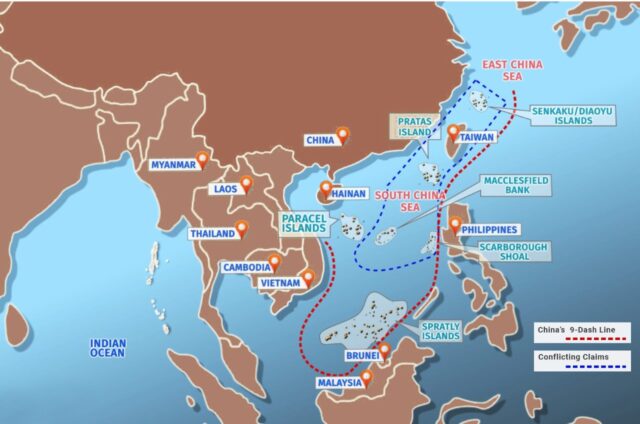NEW DELHI: April has been a busy month for much of the world with the Coronavirus ravaging their backyards. China seems to have capitalized on that pre-occupation, pushing forward its claims in the South China Sea with a combination of the physical and the diplomatic.
Earlier this month, China announced it had set up two new districts on Hainan Island to administer its South China Sea territories. One district covered the islands and reefs of the Paracel Islands and the Macclesfield Bank (claimed by Vietnam and Taiwan), with a local government located on Woody Island. The other announcement covered the Spratly chain with a local government located on Fiery Cross Reef, which the Philippines claims as its own. A protest from Manila was ignored.
Business Insider magazine quoted Prof. Kang Lin of Hainan University as saying that “there have been continuous scuffles with foreign powers in the waters nearly every month. China sees the need to step up its claim of sovereignty over its territory. As the artificial islands and essential infrastructure are now well in place, it is the right time to make administrative control more effective”.
Kang indicated that the local administrations would serve as “front line buffers”, moving to deal with any immediate problems that came up.
But the view in Singapore, which is in the neighbourhood and has no territorial claims in the South China Sea, is less benign. Collin Koh of Singapore’s Rajaratnam School of International Studies warns that “this move comes amid the ongoing negotiations on the code of conduct (governing behaviour in disputed waters). Beijing is seeking to consolidate its gains in the South China Sea before the code gets promulgated”.
Beijing is pushing the 10-nation ASEAN grouping hard on the code of conduct, banking on the code coming into force by 2022, if not earlier. Despite their reservations and concerns, much of ASEAN appears to be on board. Economically tied to China and lacking any credible military power, ASEAN appears resigned to its fate. Vietnam is the sole hold-out but for how long is debatable. Even if no code materialises, China would have anyway strengthened its position in the seas that bear its name.
U.S. Secretary of State Mike Pompeo accused Beijing of taking advantage of the COVID distraction. “China’s unilateral announcement of administrative districts over disputed islands and maritime areas in the South China Sea, its sinking of a Vietnamese fishing vessel earlier this month and its ‘research stations’ on Fiery Cross Reef and Subi Reef.”
The U.S. Navy has stepped up FONOPs (freedom of navigation operations), sailing its naval vessels close to the 12-mile territorial limit of artificial islands China has dredged up; even sending a guided missile destroyer through the Taiwan Straits in a show of force. U.S. Navy ships have also been spotted in the waters where Malaysia and China have a dispute. But it’s not clear if the U.S. has a broader or bigger game plan.
“The US sees a need to challenge Chinese activities in the South China Sea to avoid a fait accompli,” says Jayadeva Ranade of the Delhi-based Centre for China Analysis & Strategy, “but currently they are preoccupied with combating the Coronavirus, and the elections to follow in November, so President Trump has enough on his hands.”
Nevertheless, Washington has other cards to play. It has handed out over $35 million in emergency health funding to help ASEAN states combat the Coronavirus and has launched a project to promote health security through research, public health and training in the region.
In a message clearly aimed at China’s allies in ASEAN Cambodia and Laos, Pompeo also slammed Beijing’s dam building on the upper reaches of the Mekong River, which is endangering the lives of millions downstream in these countries, Vietnam and Thailand.
Then there’s the spreading boycott of China’s hi-tech industry including 5G firms like Huawei, and the call on U.S. industry and business to pullout from China. It will not happen tomorrow but American executives say they are halting fresh investments while looking to diversify their operations away from China. Returning to the U.S. may not be an option for many companies, but South-east Asia and India are options that are being explored.
















